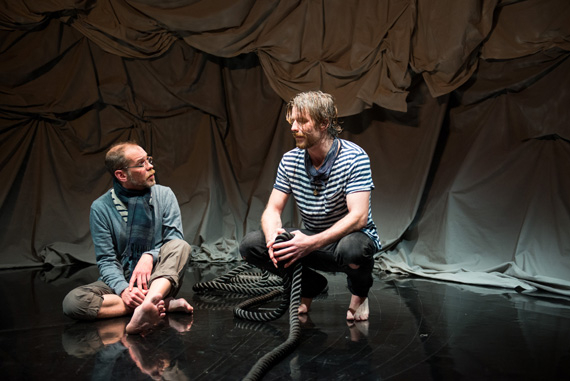
(© Cherylynn Tsushima)
Nothing says January in New York like a theatrical meditation on death by hypothermia. That’s what audiences are in for when they go see Norwegian playwright Jon Fosse’s I Am The Wind at 59E59 Theaters. This US premiere is directed by Paul Takacs, artistic director of The Shop. One part poem and one part dramatic painting, I Am the Wind is 100 percent depressing (for a variety of reasons).
Jon Fosse is one of the most produced living playwrights. His plays have been translated into 40 languages and have received over 900 separate productions around the world. He’s regularly on short lists for bookmakers looking to take bets on the Nobel Prize for Literature. If literary merit can be established on the basis of popularity (among critics and the general public), Fosse has it.
Yet that fact is a hard pill to swallow after a viewing of this dreary play, which is as warm as a codfish and loaded to the gills with faux profundity and purposeful obfuscation. The space is barren, decorated only with gray-and-blue cloth backdrops to give us our watery location. Taking place entirely on a sailboat, the play stars Christopher Tierney (who had his own very public brush with death) as “The One” and Louis Butelli as “The Other.” (This too-clever-by-half naming is the theatrical equivalent of calling a painting “Untitled #53.”) Tierney looks like a maritime Kurt Cobain with his black-and-white horizontal stripes and greasy blond locks (and sadness). Butelli appears to be a cross between Bob Balaban’s character in Moonrise Kingdom and Bob Balaban’s character in Girls. For the purpose of clarity, I’ll hereafter refer to each character by the name of the actor who plays him.
Butelli asks Tierney a lot of leading questions like, “Why don’t you want to be on your own?” and “What is it you don’t like about yourself?” This nautical therapy session leads to the revelation that Tierney has suicidal tendencies. “I’m a concrete wall that’s breaking into pieces,” he shares, later explaining that he thinks about jumping off the boat into the freezing water “all the time.” Naturally, this seems like the perfect time to unmoor the boat and navigate further into the dark and forbidding sea.
Both actors do a fine job considering what they have to work with: an inscrutable script, a length of rope, and an empty space. Thanks to their sympathetic performances, I Am the Wind does occasionally succeed in making you feel things, besides boredom. During the final moments, in which Butelli is sailing solo, you feel his panicked loneliness and desperation. Tierney is even able to make his suicidal character relatable without the seemingly important crutches of circumstance and backstory. This is no small feat!
Yet good acting can never make up for a hollow script. (Simon Stephens translated the original Nynorsk into English, “as loyally as possible,” according to Fosse.) More charitable viewers will hail I Am the Wind for its ability to distill human emotions into their purest form and convey them with simple and uncluttered language, but there is a fine line between brevity and incoherence. I Am the Wind regularly steers off course into the realm of the latter.
If you’re not particularly interested in committing an hour to an inarticulate back-and-forth about depression, you might want to skip out. Of course, if you’re fascinated by the suicidal impulses of people who own sailboats, by all means see this show.









